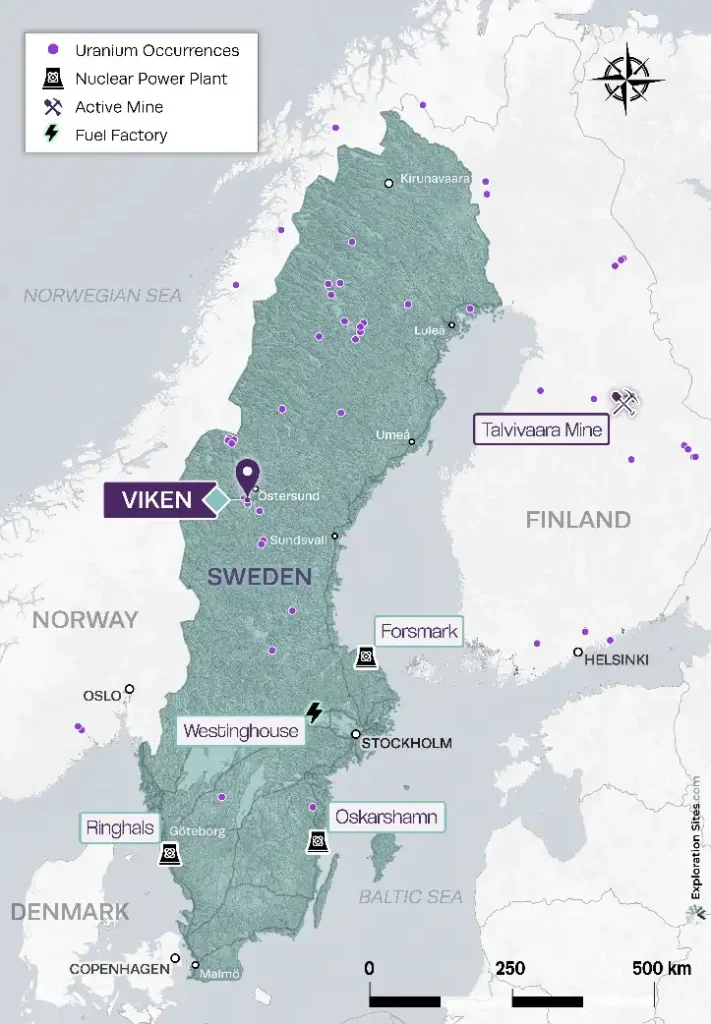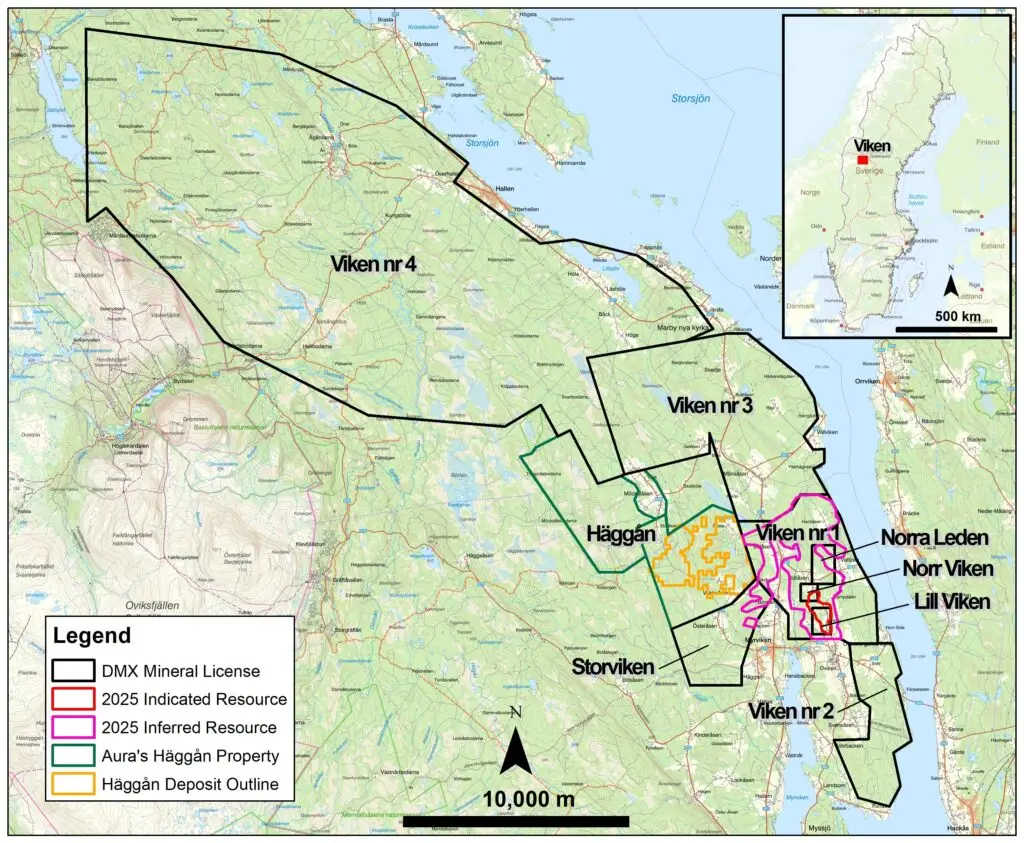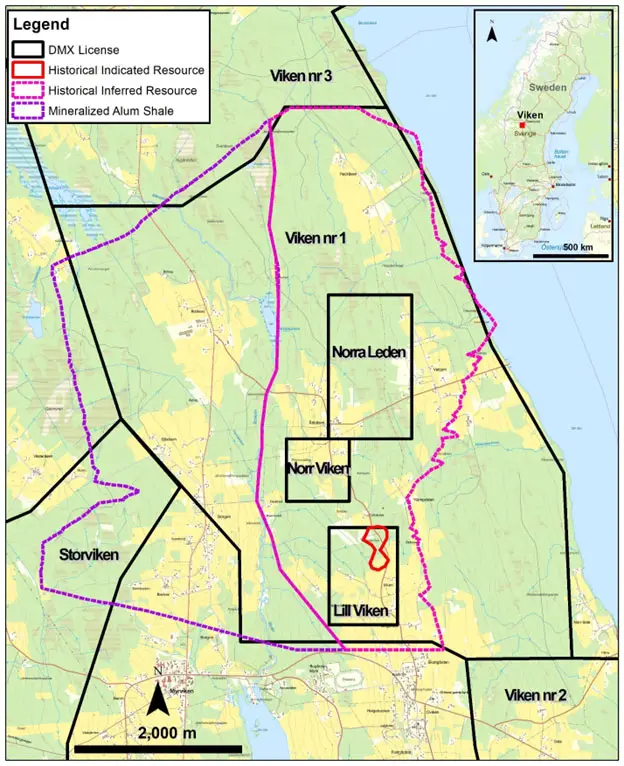
Viken – Sweden
Related News
Overview
From April to December 2023, District Metals consolidated 100% of the Viken Energy Metals Deposit located in Jämtland County, central Sweden (Figures 1 and 2) through mineral license application and acquisition.
The Viken Deposit contains an Inferred Mineral Resource Estimate of 4.3 Billion Tonnes at a Grade of 161 ppm U3O8 Containing 1.5 Billion Pounds U3O8, which is the largest undeveloped mineral resource estimate of uranium in the world along with significant mineral resource estimates of vanadium, molybdenum, nickel, copper, zinc, and other important and critical raw materials1.
The Viken Property totals 38,657 hectares (ha) where the Viken nr 1 mineral license covers the majority of the Viken Deposit. The Norra Leden, Norr Viken, Lill Viken mineral licenses cover the southeast and east areas of the Viken Deposit that remain open to the south and east based on historic drill results.
The Storviken mineral license covers the southwest corner of the Viken Deposit that remains open to the south and west based on historic drill results that are consistent with historic drill results from within the Viken Deposit.
The Viken nr 2 and 3 mineral licenses also contain historical drill holes that returned grades and widths of polymetallic mineralization consistent with historic drill results from within the Viken Deposit.
The Viken nr 4 mineral license covers ground that is highly prospective for mineralized Alum Shale energy metals deposit targets based on available geological, geochemical, geophysical, and radiometric survey data.
Table 1: 2025 Mineral Resource Estimate for the Viken Deposit(1-8)
| Indicated | Tonnes (Million) | U₃O₈ ppm | V₂O₅ ppm | Mo ppm | Ni ppm | Cu ppm | Zn ppm | Ce₂O₃ ppm | P₂O₅ ppm | Y₂O₃ ppm | La₂O₃ ppm | K₂O % |
| 456 | 175 | 2,836 | 257 | 330 | 113 | 411 | 88 | 2,461 | 492 | 7 | 3.84 | |
| Pounds (Million) | Tonnes (Million) | |||||||||||
| Contained Metal | 176 | 2,851 | 258 | 332 | 114 | 413 | 0.04 | 1.12 | 0.22 | 0.00 | 17.53 | |
| Inferred | Tonnes (Million) | U₃O₈ ppm | V₂O₅ ppm | Mo ppm | Ni ppm | Cu ppm | Zn ppm | Ce₂O₃ ppm | P₂O₅ ppm | Y₂O₃ ppm | La₂O₃ ppm | K₂O % |
| 4,333 | 161 | 2,543 | 240 | 321 | 118 | 417 | 88 | 2,541 | 528 | 7 | 3.7 | |
| Pounds (Million) | Tonnes (Million) | |||||||||||
| Contained Metal | 1,538 | 24,295 | 2,293 | 3,067 | 1,127 | 3,984 | 0.38 | 11.01 | 2.29 | 0.03 | 160.27 | |
| Indicated | Tonnes (Million) | U₃O₈ ppm | V₂O₅ ppm | Mo ppm | Ni ppm | Cu ppm | Zn ppm | Ce₂O₃ ppm | P₂O₅ ppm | Y₂O₃ ppm | La₂O₃ ppm | K₂O % |
| 456 | 175 | 2,836 | 257 | 330 | 113 | 411 | 88 | 2,461 | 492 | 7 | 3.84 | |
| Pounds (Million) | Tonnes (Million) | |||||||||||
| Contained Metal | 176 | 2,851 | 258 | 332 | 114 | 413 | 0.04 | 1.12 | 0.22 | 0.00 | 17.53 | |
| Inferred | Tonnes (Million) | U₃O₈ ppm | V₂O₅ ppm | Mo ppm | Ni ppm | Cu ppm | Zn ppm | Ce₂O₃ ppm | P₂O₅ ppm | Y₂O₃ ppm | La₂O₃ ppm | K₂O % |
| 4,333 | 161 | 2,543 | 240 | 321 | 118 | 417 | 88 | 2,541 | 528 | 7 | 3.7 | |
| Pounds (Million) | Tonnes (Million) | |||||||||||
| Contained Metal | 1,538 | 24,295 | 2,293 | 3,067 | 1,127 | 3,984 | 0.38 | 11.01 | 2.29 | 0.03 | 160.27 | |
Notes:
- Mineral resources which are not mineral reserves do not have demonstrated economic viability. The estimate of mineral resources may be materially affected by environmental, permitting, legal, title, taxation, socio-political, marketing, or other relevant issues.
- The Inferred Mineral Resource in this MRE has a lower level of confidence than that applied to an Indicated Mineral Resource and must not be converted to a mineral reserve. It is reasonably expected that the majority of the Inferred Mineral Resource could be upgraded to an Indicated Mineral Resource with continued exploration.
- The mineral resources in this MRE were estimated using the Canadian Institute of Mining, Metallurgy and Petroleum (CIM), CIM Standards on Mineral Resources and Reserves, Definitions (2014) and Best Practices Guidelines (2019) prepared by the CIM Standing Committee on Reserve Definitions and adopted by the CIM Council.
- The MRE was based on consensus economics forecast US$ metal prices of $72/lb U3O8, $5/lb V2O5, $17/lb Mo, $8.50/lb Ni, $4.25/lb Cu and $1.30/lb Zn with process respective recoveries of 80%, 80%, 70%, 70%, 50% and 75%, respectively.
- Overburden, waste and mineralized US$ mining costs per tonne mined were respectively $2.00, $2.50 and $3.00.
- Processing and G&A US$ costs per tonne processed were respectively $20 and $2.
- Constraining pit shell slopes were 45 degrees.
- Eugene Puritch, P.Eng, FEC, CET, President of P&E Mining Consultants Inc., is a qualified person as defined in NI 43-101, and is responsible for reporting mineral resources for the Viken Deposit. Mr. Puritch is independent of the Company. Additional P&E independent Qualified Persons contributing to the MRE are William Stone, PhD, P.Geo., Fred Brown, P.Geo., David Burga, P.Geo., Jarita Barry, P.Geo. and D. Grant Feasby, P.Eng.
Figure 1: Location Map

The Scandinavian Alum Shales
The Baltoscandian Platform, from Finnmark in northern Norway to Skåne in southern Sweden, was an area of great stability during the Late Cambrian, with deposition of a thin (10 to 60 m) shale facies along with large amounts of organic matter. This shale deposition started in many areas in the Middle Cambrian and continued in some areas into the earliest Ordovician (Tremadoc). The content of organic matter is commonly in the order of 10%, locally over 20% and very occasionally up to almost 30%. In areas such as Närke, Ostergötland and Kinnekulle, that have not been influenced by temperatures in excess of 100°C, the brown shales yield significant amounts of oil (Fischer assays of 6 to 7%). In other areas, oil-yields are lower or absent; the shales are darker in colour, the organic matter varying in maturation from bituminous to semi-anthracitic or even anthracitic and graphitic towards the interior of the Caledonides.
These organic-rich shales, composing the Alum Shale Formation, are remarkable for their syngenetic concentration of a variety of trace elements, in particular, uranium and vanadium, but also molybdenum, nickel, zinc, copper, rare earth elements, potash and phosphate. Throughout Scandinavia, uranium contents are highest in the Peltura scarabaeoides zone reaching a maximum of 306 ppm over a thickness of 3.6 m in the Ranstad area of the Billingen-Falbygden outlier. Vanadium contents generally (Jämtland excepted) do not exceed 1,000 ppm in the Upper Cambrian but rise rapidly between 2,000 to 3,000 ppm in the Dictyonema zones of the Tremadoc. Even in areas where the general level of these trace elements is lower, the variation in their concentrations is closely related to the stratigraphy. This may also be the case further to the south and southwest where black shales of similar age occur in Poland, in the Anglo-Welsh area, and in eastern Canada on Avalon and in the Maritime Provinces.
The Alum Shale Formation contains Sweden’s most important reserve of fossil energy; oil yields are significant and greatly increased by retorting in hydrogen under pressure. The formation contains the largest uranium resource in Europe, the uranium-rich unit of the Billingen-Falbygden outlier alone containing about a million tonnes of uranium. In the Caledonides, tectonically repeated alum shale successions, several tens of meters thick, contain a combination of unusually high trace element concentrations (200-240 ppm U, 350-400 ppm Mo, 1500-2000 ppm V). The Alum Shale Formation has considerable economic potential2.
Figure 2: Viken Property Mineral Licenses

The Viken Energy Metals Deposit
The Viken Deposit is situated in the province of Jämtland, approximately 570 km northwest of Stockholm, Sweden. Infrastructure is well developed in the area with daily air service, as well as rail and truck freight services. Electrical power and modern communications are also readily available in the area.
The Geological Survey of Sweden (SGU) carried out work on the Alum Shales from 1977 to 1978 and drilled approximately 19 holes within and in the vicinity of the Viken Deposit. In 2005, Continental Precious Minerals Inc. (CPM) purchased mineral licenses that covered prospective Alum Shales where CPM drilled 26,293 m in 122 holes from 2006 to 2012 to delineate the Viken Deposit.
CPM retained P&E Mining Consultants Inc. to complete a mineral resource estimate and PEA in 2010, which was further updated in 2014.
The Viken Deposit is a polymetallic shale resource contained within the Cambrian Viken Shale which regionally is referred to as the Alum Shale. The Alum Shale is enriched in metals such as vanadium, uranium, nickel, copper, zinc, molybdenum, and important and critical raw materials. It occurs over a significant area in Sweden and is locally valued as a bituminous shale with recoverable hydrocarbons. The Alum Shale is regionally extensive in Sweden.
The stratigraphy across the Viken Mineral License application consists of upper Middle and Upper Cambrian age Alum Shale occurring as both in situ and fault detached blocks, with the latter having greater potential for economic mineralization due to imbrication of mineralized blocks. The Alum Shale is mostly exposed at surface and is underlain by Proterozoic granites and gneisses thrust Eastward over Archean granitic basement rocks. The thickness of the Alum Shale host rock has been tectonically thickened from 20 to 30 m by thrusting and folding during the Silurian to approximately 180 m.
Mineralization of potential economic significance is hosted in Middle and Upper Cambrian Alum Shale, with the Upper Cambrian age strata more enriched in vanadium and uranium than the Middle Cambrian2. Vanadium occurs within the lattice of a mica mineral named roscoelite. Uranium values are predominantly associated with sub-micron-scale uraninite crystals. Nickel, molybdenum, copper and zinc are present as sulphides.
Figure 3: Viken nr 1 Mineral License and Viken Deposit Outline

References
1 See District Metals’ news release dated April 29, 2025.
2 Andersson, A., Dahlman, B., Gee , D. G . , and Snäll, S, 1985: The Scandinavian Alum Shales. Sveriges geologiska undersökning, Ser. Ca, No. 56, pp. 1-50. Uppsala 1985.

